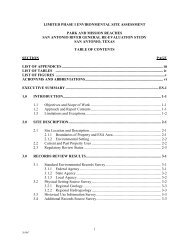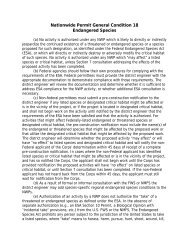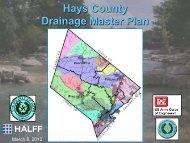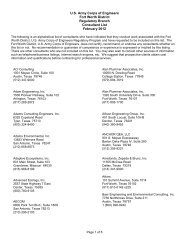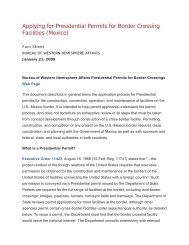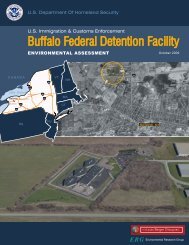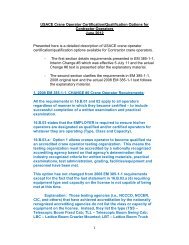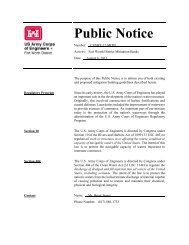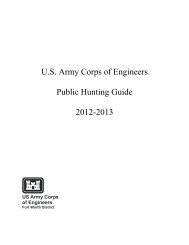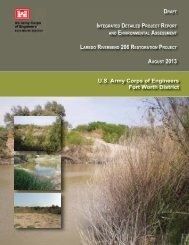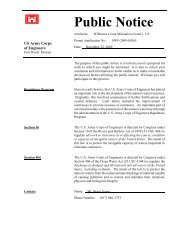environmental assessment us border patrol, tucson sector
environmental assessment us border patrol, tucson sector
environmental assessment us border patrol, tucson sector
Create successful ePaper yourself
Turn your PDF publications into a flip-book with our unique Google optimized e-Paper software.
3-321234567891011121314151617181920212223242526272829303132333435363738394041424344454647when they surrendered to United States troops and were confined to reservations (Ferg<strong>us</strong>on et al.2004).A historic Euroamerican presence in the San Pedro River Valley began with the arrival of theSpanish in the late 1600s and 1700s. Intensive occupation of the region did not occur until afterthe arrival of Mexicans in 1821, and then later by Americans in the mid-nineteenth century.Renewed raiding by Apache groups in the years immediately following the Civil War led to theestablishment of military forts throughout much of the region. After decades of conflict betweenHispanics and Anglos (including the U.S. Army and the allied Pima-Maricopa Confederation)and Apache, significant changes came to the region, such as the establishment of the San CarlosReservation (Limerick 2000). Fort Huachuca was founded in 1877 in order to protect settlersand travel routes in southeastern Arizona (Steinitz et al. 2002:25), as well as to block possibleApache escape routes into Mexico.In the 1870s, mining flourished throughout southeastern Arizona. By the following decade, theCopper Queen Company at Bisbee was exploiting one of the area's largest copper deposits. In1877, silver was discovered at Tombstone, setting off a boom that drew throngs of prospectors toArizona, but lasted less than 10 years. By 1880, the Santa Fe and Southern Pacific railroads bothextended into Arizona. Ranching began to thrive with cattle and sheep h<strong>us</strong>bandry. After 1897,the U.S. Forestry Bureau issued grazing permits to protect public land from depletion.Statehood PeriodWhen President William H. Taft signed legislation making Arizona a state on February 14, 1912,most of the population of Cochise County lived in towns along the San Pedro River. With morepeople came demands for more water and other resources. Historic Anglo occupation of theregion has been dominated by agriculture, ranching, and mining. Ranching and mining, inparticular, has been important to the local economy.Immigration and tourism have contributed to economic growth in the region throughout much ofthe last century. Beginning in the late nineteenth century, the health benefits of southernArizona’s warm and arid climate were promoted, and by the early part of the twentieth century,tho<strong>us</strong>ands of people with tuberculosis had settled in the area. Dude ranching also became apopular activity for eastern tourists during this time. Federally funded public works projects keptmany people in southern Arizona employed during the Depression. In particular, the CivilianConservation Corps hired local men to build roads, bridges, parks, and trails throughout theregion, many of which are still in <strong>us</strong>e today. When the United States entered World War II in1941, the local economy shifted to support the war effort, reflected most dramatically in theexpansion of the Fort Huachuca military base. Many of the servicemen who trained at FortHuachuca settled in southern Arizona after the war to raise their families. The population ofsouthern Arizona increased sharply after World War II, nearly doubling every decade. The latestcens<strong>us</strong> figures put the total population of Cochise County at close to 120,000.3.8.1.2 Previo<strong>us</strong> InvestigationsGSRC conducted a records search and literature review of previo<strong>us</strong> investigations and previo<strong>us</strong>lyrecorded sites within a 1-mile buffer surrounding the entire project area. The currentinvestigation resulted in the identification of only one previo<strong>us</strong> project. A powerline clearancesurvey was conducted in 1990 by Cultural and Environmental Systems, Inc. (Heuett andDouglas FOB EADraftAug<strong>us</strong>t 2011



